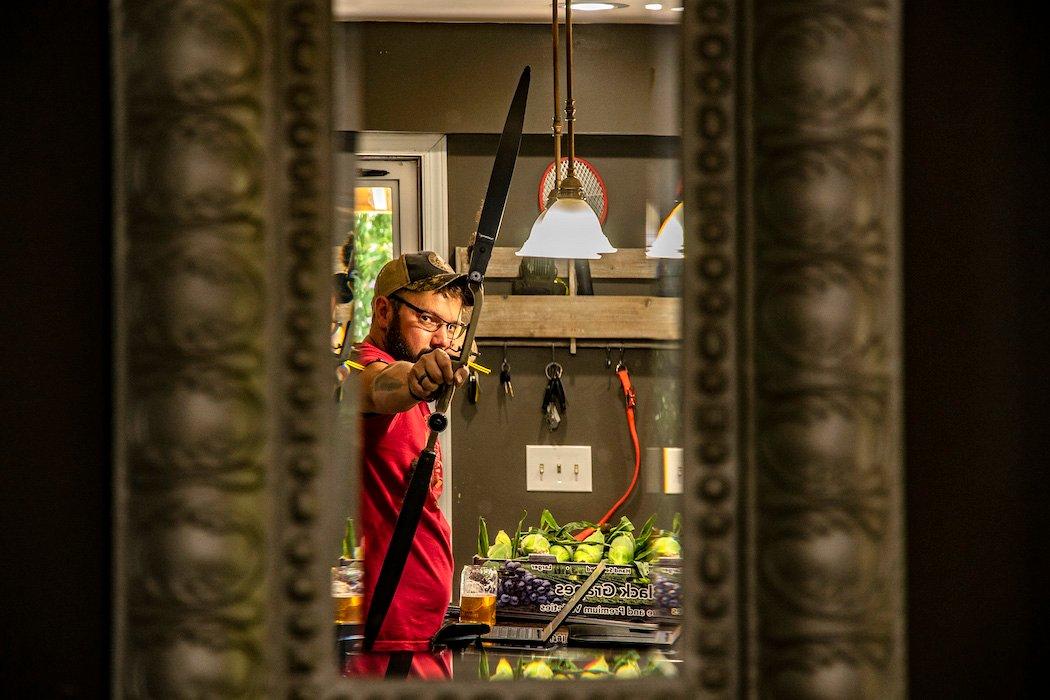Trading your compound bow for a recurve adds a whole new twist to your bowhunting experience
Over the past few years, traditional archery has surged in popularity among recreational shooters and bowhunters alike. For many, making the switch from a compound to a recurve or long bow is a way to increase the challenge of a hunt; for others, it's a way to embrace the simplicity of traditional archery. Choosing to bowhunt with traditional gear not only requires hunters to get closer to game but also to spend a significant amount of time practicing with their equipment to become proficient.
When it comes to equipment selection and shooting style, there are many differences between a stick bow and a wheel bow that can be confusing for traditional newcomers. So, I recruited the help of long-time traditional bowhunter Travis T-Bone Turner to help you understand where to get started with traditional archery.
Select a Bow
If you think there are a lot of options in the compound market, you're in for a surprise when it comes to selecting a traditional bow. First, you'll have to choose between a manufacturer's bow and a hand-made model. Many manufacturers produce traditional bows on a large scale, but bowyers all across the country make beautiful, hand-crafted recurves, long bows and self-bows. It can be tempting to shell out for a beautiful hand-made bow, but there are plenty of fantastic options from manufacturers for a more affordable price.
You'll also need to decide between a one-piece bow and a take-down bow, though Turner recommends a take-down style recurve for new traditional archers. Take-downs provide more versatility because they allow you to swap out limbs. You'll also need to consider the length of the bow.
I'd suggest a guy go with a little bit longer bow, Turner says. Something that's 64 or 66 inches, the string won't be so tight on your fingers and they're easier to aim.
Choose a Draw Weight
Selecting your new bow's draw weight can be one of the most difficult decisions when making the jump to traditional archery. Most compound shooters today are pulling 65 to 70 pounds but, after let-off, are typically holding less than 20 pounds at full draw. With a traditional bow, that poundage builds as the bow is drawn, leaving the shooter holding the most weight at full draw. Turner says one of the biggest mistakes new traditional archers make is choosing a bow with a draw weight that's too heavy. Go for a 35- to 40-pound draw weight starting out, and adjust that according to your own needs.
Don't think you have to be a macho man, Turner says. A slow hit is better than a fast miss.
Note, too, that draw weight is measured differently for traditional bows. The weight-rating of a traditional bow is measured when the bow is drawn to 28 inches. As the draw length changes, the bow will gain or lose roughly 3 pounds per inch. For example: If you start out with a 40-pound bow and you have a draw length of 30 inches, you would actually be pulling about 46 pounds.
Choose a bow with a comfortable draw weight that will help you develop good form and accuracy. This is also where choosing a take-down model comes in handy, because you always have the option to change limbs as you build your strength - without the added cost of buying a second bow.
Develop a Style
Once you have your bow, you need to select a shooting style. Some archers use the split-finger method, placing their index finger above the arrow, and the middle and ring fingers below it. The alternative is the three-under method, where the index, middle, and ring finger draw the string from below the arrow.
Choosing which style is right for you really comes down to personal preference. Try both and see what feels right. Shooting with split fingers is generally used for the instinctive shooting method, while three-under puts your eye closer to the arrow, allowing you to look down the arrow at full draw.
For compound shooters who are used to having a pin to aim, three-under is usually easier since you use the tip of your arrow as a sight reference, Turner says. It used to be about a 50/50 split between the two, but today there seems to be more people shooting three under.
Add a Draw Check
Unlike a compound bow, traditional bows don't have a back wall or draw stops. Because variation in draw length directly affects the energy a bow will produce, it's critical to develop a consistent draw. That's where draw checks come in handy. They provide a reference that allows you to draw to the same length every time.
The most common type of draw check is a clicker. This small accessory consists of a piece of cord tied between the bow string and a metal tab on the upper limb of your bow. When you reach the desired draw length, the cord tightens and causes the tab to click. Using a clicker will help with consistency, but hunting with one is a topic of debate. Some folks dislike the noise in a hunting situation, but Turner finds them useful.
Clickers are a great way to make sure your shot is consistent, Turner says. In a hunting situation when the adrenaline gets pumping, it can be easy to over-draw, so I think clickers are a good idea. Regardless of how you do so, establish a consistent anchor point. Implement a knuckle on the jaw bone or ear lobe, a thumb along the jaw line, or some other consistency."
Tune the Arrow to the Bow
Shooting an arrow with the correct spine is important for both compound and traditional setups. With a compound, however, there's more room for adjustment.
With a compound, you can't have too stiff of a spine, in my opinion, Turner says. With a traditional bow, you need that arrow to flex so it bends around the riser of the bow.
When setting up a traditional bow, it's important to remember that you don't tune the bow to the arrow, as is commonly done with a compound. Instead, you tune the arrow to the bow. There are a couple different ways to do this.
I'm a big fan of heavy FOC, says Turner, referring to the arrow's front-of-center, or the percentage of the arrow's weight that's in the front half of the arrow. By adjusting the FOC by changing the arrow's point weight, you can change its spine. Starting with a long arrow and cutting it down a little at a time is another way I tune my arrow to get good arrow flight.
When tuning an arrow, remember that increasing point weight - the FOC - will weaken the spine of the arrow; shortening the arrow shaft will make it stiffer. To evaluate arrow flight, tune the bare shafts and paper tune until you get a perfectly flying arrow. If your arrows aren't flying straight, you're going to lose energy and penetration. Adjust arrow length and point weight until you get it right, and don't worry what arrow weight or point weight you end up with.
Get Closer
There are a lot of things to consider when making the change from a compound to traditional bow, and you'll learn as you go. Just make sure to ramp up the frequency of your practice sessions, since consistent accuracy will be more challenging to achieve than with your compound.
The standard distance for target practice seems to be 20 yards, but with a traditional bow, don't be afraid to move up to 10 or 15 yards when you're first starting out, Turner says. He also notes that you'll want a glove or tab for your string hand. Try out several different gloves and tabs to find what you like best. If you go with a glove, buy a size smaller than you would typically wear because that leather will stretch, and a sloppy glove can make it hard to get a good release.
When it comes to working on your shooting form, try drawing your recurve in front of the mirror or camera to ensure the bow string stays straight up and down. A lot of people will turn their hand out as they draw, making the string curve. And remember: Perfect form isn't as important as consistent form.
Don't Miss: Archery Tips from the Pros
Check out more stories, videos and educational how-to's on bowhunting.












